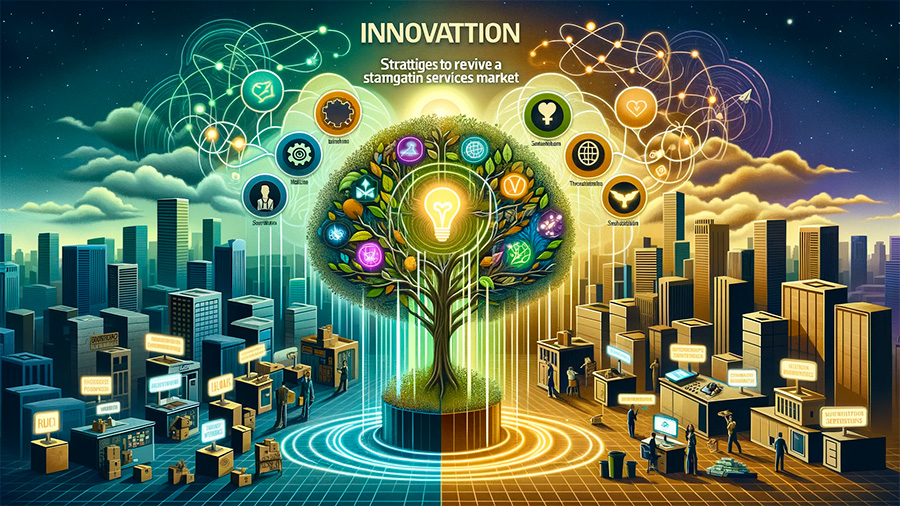In today’s competitive landscape, many services markets are experiencing stagnation, characterized by low growth, reduced consumer interest, and heightened competition. To overcome these challenges, businesses must embrace innovation and explore new business models that can revitalize their offerings and attract new consumers. This article discusses strategies for leveraging innovation to breathe new life into a stagnant services market.
Understanding the Causes of Stagnation in Services Markets
Stagnation in services markets can stem from various factors, including market saturation, changing consumer preferences, and increased competition. Identifying these causes is essential for developing effective strategies to revive interest and stimulate growth.
1. Market Saturation
As more businesses enter the market, consumers may find themselves overwhelmed by options, leading to a lack of differentiation among service providers. This saturation can result in price wars and diminished profit margins.
Impacts of market saturation:
- Decreased brand loyalty: Consumers may switch between providers based on price, leading to reduced customer retention.
- Reduced innovation: Intense competition can stifle creativity, as businesses focus on cost-cutting rather than developing new offerings.
2. Changing Consumer Preferences
Consumer preferences are continually evolving, driven by technological advancements, shifting societal norms, and changing lifestyles. Businesses that fail to adapt to these changes risk losing relevance in the market.
Consequences of changing preferences:
- Demand for personalization: Consumers increasingly expect personalized experiences tailored to their specific needs and preferences.
- Focus on sustainability: Growing awareness of environmental issues drives consumers to seek out sustainable and socially responsible service providers.

Strategies for Reviving a Stagnant Services Market
To combat stagnation, businesses can implement various innovative strategies that attract consumers and stimulate growth.
1. Embrace Technological Innovation
Investing in technology can enhance service delivery, improve operational efficiency, and create unique value propositions. Businesses should explore emerging technologies that can streamline processes and elevate the customer experience.
Technological innovations to consider:
- Automation: Implement automation tools to optimize operations, reduce costs, and enhance service delivery.
- Data analytics: Use data analytics to gain insights into customer behavior, allowing for more targeted marketing and personalized service offerings.
2. Adopt New Business Models
Exploring new business models can help businesses differentiate themselves and capture new market segments. Companies should consider innovative approaches that align with changing consumer preferences.
Examples of new business models:
- Subscription services: Offering subscription-based services can create steady revenue streams while providing convenience for consumers.
- Freemium models: Providing basic services for free while charging for premium features can attract a larger audience and drive conversions.
3. Enhance Customer Experience
Delivering an exceptional customer experience is vital for attracting and retaining consumers. Businesses should prioritize understanding customer needs and preferences to create tailored experiences.
Ways to enhance customer experience:
- Personalization: Leverage data to offer personalized recommendations, improving customer satisfaction and loyalty.
- Seamless interactions: Ensure that customer interactions across all touchpoints—online and offline—are smooth and consistent.
4. Foster Collaboration and Partnerships
Collaboration with other businesses can lead to innovative solutions and expanded offerings. Partnerships can create synergies that enhance service delivery and attract new customers.
Benefits of collaboration:
- Shared resources: Partnering with other organizations can provide access to new technologies, expertise, and customer bases.
- Co-branded offerings: Collaborating on co-branded services can leverage each partner’s strengths and attract a wider audience.
5. Focus on Sustainability and Social Responsibility
As consumers become increasingly aware of social and environmental issues, businesses that prioritize sustainability and social responsibility can attract a loyal customer base.
Strategies for promoting sustainability:
- Eco-friendly practices: Implement sustainable practices in operations, such as reducing waste and energy consumption.
- Community engagement: Engage with local communities and support social initiatives to build a positive brand reputation.

Measuring Success and Adapting
To effectively revive a stagnant services market, businesses must continuously measure their success and adapt their strategies. Regularly assessing performance metrics and gathering customer feedback will help organizations refine their approaches and stay responsive to market changes.
1. Key Performance Indicators (KPIs)
Establishing KPIs allows businesses to track their progress and evaluate the effectiveness of their strategies. Common KPIs for services industries may include customer satisfaction scores, retention rates, and revenue growth.
Examples of relevant KPIs:
- Net Promoter Score (NPS): Measures customer loyalty and satisfaction based on their likelihood to recommend your services.
- Customer Lifetime Value (CLV): Estimates the total revenue a customer will generate throughout their relationship with your business.
2. Continuous Improvement
Encourage a culture of continuous improvement within the organization. Regularly review processes, gather feedback, and implement changes to enhance service offerings and operational efficiency.
Strategies for continuous improvement:
- Regular training: Invest in employee training to ensure that staff is equipped with the latest knowledge and skills to serve customers effectively.
- Solicit feedback: Actively seek feedback from customers and employees to identify areas for improvement and adapt accordingly.
Conclusion
Reviving a stagnant services market requires a multifaceted approach centered around innovation, customer experience, and adaptability. By embracing technological advancements, adopting new business models, fostering collaboration, and prioritizing sustainability, businesses can attract new consumers and stimulate growth. In an ever-evolving market, organizations must remain proactive and responsive to ensure they thrive in a competitive landscape. Through continuous improvement and a commitment to meeting consumer needs, businesses can successfully navigate the challenges of a stagnant services sector and pave the way for a prosperous future.
